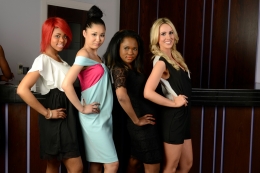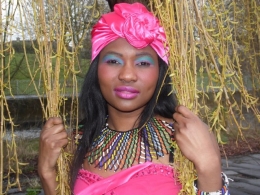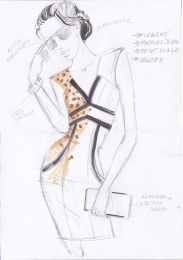Born in Zimbabwe and brought up in Ireland, designer and mother-of-two Tina Nyakambiri Williams is based between Drogheda and Dublin. Tina uses designing as a way of expressing herself and a tool for sharing her story. And she is also a milliner, borne out of the need to make her own accessories. Tina loves poetry, creative writing, cooking, dancing and hunting for bargains. Her motto is ‘nothing is impossible’ and her label Helena Kampbell is a perfect example of that!
Born in Zimbabwe and brought up in Ireland, designer and mother-of-two Tina Nyakambiri Williams is based between Drogheda and Dublin. Tina uses designing as a way of expressing herself and a tool for sharing her story. And she is also a milliner, borne out of the need to make her own accessories. Tina loves poetry, creative writing, cooking, dancing and hunting for bargains. Her motto is ‘nothing is impossible’ and her label Helena Kampbell is a perfect example of that!
Hi Tina! Can you tell us a bit about your background and education?
I have only completed my education up to second level! I have tried so many times to obtain my third level [qualification] but from an early age I knew what I wanted to do for my career.
I went into retail management straight after school, starting out with Claire’s Accessories, and later I worked with Elverys Sports as well as Xtra-Vision. These work experiences laid the foundation for my fashion design career.
At Xtra-Vision in particular, I dealt with a lot of business administration, which involved communication with suppliers, etc. All of those skills contribute to running my design business. And I love business as a subject itself, which makes it a lot easier for me.
How did you get started in fashion design?
I started out back at home when I was 10 years old. My grandmother Susanna Biriyani taught me everything I know about fashion design, including alterations and up-styling. I used to love watching her mix threads to create details for clothes she designed and made for us. I then made my first skirt alongside Astrionics Biriyani, who is my twin sister. I enjoyed it so much that we spent the summer doing a sewing boot camp.
How did you develop your design experience from there?
My designing comes from having the natural ability of creativity. I discovered I could do that, hence I did not see the relevance of doing a four-year course. However, I did learn a lot of techniques – fabric combinations, textiles, history of fashion and garments – through working alongside Mary Liberty, a fashion designer with over 25 years’ experience. She is a fashion guru who has lived in the USA, the UK and Africa.
I was her intern for over three years and she taught me unique techniques – and how to make my own accessories, too. She covered every aspect of being a successful designer. As she said to me, you are either born with creativity or not. Yes, people can go to study fashion, but it doesn’t mean they can be a designer.
What drew you to fashion design career?
After working in retail for nearly a decade and studying high street fashion very closely, I noticed that there would be a market for my design, and I did my first trial fashion show in May 2011.
I love designing because it is a way of expressing myself. Like every career, it has its up and downs, but being able to share my creativity is the best part of my work.
My first Helena Kampbell collection marked a turning point in my career, as it included my first hats. Being a designer, it is important to learn as many skills as you can, ones that are relevant to your work. However, being a milliner is not a skill that is gained overnight; I had to learn over a period of two years. I wanted to make my own accessories, and that was how I did it.
What types of material do you use?
The material depends on the garment being constructed. Certain designs combine well with certain materials.
Do you outsource any of your design process?
I do not outsource… I like to create my own collections and name them, as there is a story behind every collection and I like to tell stories through my designs. The public have only seen my first collection for Helena Kampbell, however, behind the scenes I have four different collections in the works, as well as my exclusive range Mrs S.
What does a dress creation entail?
Well it depends on many things. Sketching – what can you do with the design and what details can you add? Fabrics – what fabrics can you use, and what limitations? The garment – what techniques are going to be used? And time – how long will it take to give your creation life?
How many hours does it take to make a typical dress?
It does not take hours, it takes days, as it is a process – but a simple design can take just eight hours.
How about making a hat? What does that involve?
Creating a hat is both easy and hard. The more detail that is involved, the longer it takes. However, the above process still applies.
How would you define your style?
Style is a huge word; it covers a lot for me. My style is looking elegant, classy but at the same time nice. I like to call it elegance and beauty. But at the same time I do not follow other people’s trends that much. I aim to be a trendsetter, not a follower.
How would you define fashion?
Fashion is not just clothing – it covers beauty and accessories, too. Fashion to me is about bringing out your inner creativity, being able to identify the difference between seasons and trends as well as style. It’s about being able to dress yourself – by that I mean knowing your body shape and type. This is where beauty comes in.
What would you say is the most difficult aspect of a fashion design career?
Not having any business knowledge would be the most difficult thing, because with that comes knowing your market. In regard to production, I would say it’s impossible to produce in mass quantities if you do not have the resources and the connections. Sales and advertising are just as important. Finance is needed, of course, but there are so many ways to go about it once you can produce wearable designs.
What is your opinion of the Irish fashion industry?
I can say in Ireland it is a challenge trying to establish yourself as a designer. From my experience, no one wanted to help me until I won the African Fashion Designer award for 2013. There is not enough support for fashion. In my opinion, Ireland is still evolving regarding fashion compared to the UK. Belfast is growing with fashion, whereas here I think more needs to be done, like hosting an Ireland fashion week – they need to do a lot more competition to encourage young people to show their creative side.
Let’s not forget that Ireland has not reached a certain level of multiculturalism. If you walk in a normal dressmakers’ in Ireland, they cannot make international garments like African wear or Asian wear. There is a huge list of never-ending challenges within Ireland. As for me, I hold to the motto ‘fashion is my passion’. It is my dream, and no one is going to stop me from making it happen. Nothing is impossible!
What, in your opinion, are the most important skills in running a fashion design business?
It is important to be able to identify your fabrics and materials, to know your colour chart – your base colours, cool colours and warm colours – and your fabric combinations, to have the ability to go that extra mile with your creativity and create sellable designs. Techniques are important as each garment requires different skills. I could go on, the list is endless. The most important skill is creativity; once you have it, you can go a long way.
What do you wish you had known before setting up your design business?
The fashion industry is harsh: your collection is either a major success or a failure. There are a lot of things I wish I had known, but I am there now and it is my reality.
I sketch and design all my work but at the moment I like my designs to be realistic. A friend who is a professional illustrator completes the sketches for me as they need to be high quality for the internet. All the designs are mine, but its great having help, too.
What advice would you give to a newbie fashion enthusiast?
You need to be able to keep up with the fashion industry as it is a very fast-paced environment. Let me break it down: you need to know about fashion history, textiles and much more. If you know everything, it helps when making collections as you need to give direction to bring your creation to life.
Never think you can do it alone. I have people that help me a lot, especially with the production end. I would not have made it this far without the help of Fashion Hot House. It’s just not about design, it’s about getting to know people because you cannot do it alone. When you make it, never forget the people that were there along the way. Select a team and stick with them – just make sure you work well together.
As a designer it is important be able to create wearable designs, so when making your collection do not think about what you would like. Think about your clients first, because you will not be wearing the clothes – they will!
But above all, never give up, and do not let anyone put you down or hold you back.
What are your long-term plans?
I have a lot of plans and collections on the way. I am excited about the future of Helena Kampbell. I am looking to celebrate with other designers to host fashion shows and collections. My label is going to go global – but I have to thank my staff and everyone who has made that possible.














